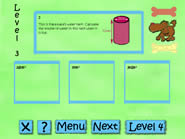Delivery

Matt created a computer Survival quiz to test his sister on a Natural Disaster unit she was studying at primary school. He included sections on Earthquakes, Floods, Volcanoes and Storms.
So he could quickly add to the content when his sister became confident at the game; and to ensure the questions were asked in a random order, Matt stored the questions, multi-choice answers, correct answer and image name, in four linked text files.
The player learns to analyse the photograph and answer the question below.
In the first project module of 2006, students were asked to create a cover for their Technology portfolio to express their place in today's technological society. This involved learning the basic principles and practices of graphic design and working through the technological practice process including scanning, drawing, painting, and photographing and compositing an image.
The second project module students were introduced to the Visual Basic programming language and worked through a series of exercises. This was followed by a two-week unit standard task where they applied their skills to planning and designing a simple program.
"In both modules, the techological practice was naturally embedded into the development process students followed," says Jenny. "It wasn't made an issue. It was just: 'this is the way we do things'."
The students then moved on to the major project of the year. Jenny had outlined the project at the beginning of the year, giving the students plenty of time to get their heads around the issues involved. After outlining the project - to develop software to meet a specific learning need - Jenny asked her students to identify a user (at level one, Jenny prefers the term 'user' to 'client') with a specific learning need and investigate that need over the coming weeks.
The users identified by the students had a range of needs. One student had a ten-year-old sister who was just starting to do algebra; he wanted to make the subject fun, because when he had done it he had found it intimidating. Another wanted to create a learning programme that would teach his sister about healthy eating and lead her through the choices she had. Several students worked with ESOL students and one worked with the school's learning support unit. Extensive research was conducted into the specific learning problems involved.
"They had the whole first term to think about who their key user would be, what the specific learning needs were and how they might address them."
At the end of the first term, Jenny asked her students to spend time during the break looking at educational computer programs and working out which ones they liked and which ones they didn't and why.
In the second term, the class looked into the history of computer games, beginning with Pong (based on table tennis, Pong originally released by Atari in 1972 and is commonly thought to be the world's first video arcade game). The class also looked at interface and usability design, using video material Jenny had recorded in ICT companies during her 2004 fellowship year.
"They identified things they had to think about in order for their project to be successful. We came up with an 'inspiration' diagram.
One of the key points identified by the cluster group was the need to stimulate student creativity. Through frequent interactions with facilitator Hugh Derham, the teachers learned many ways to foster creativity.

Nethya created a computer game to help an ESOL student struggling with English learn the terminology used in the measurement unit in mathematics.
Nethya saved the maths questions, multi-choice answers, correct answer and image name; in a text file linked to the game, so the mathematical content could be easily extended as the student became more confident.
The player learns to analyse the diagram and answer the question.
"Hugh's input was invaluable. He stimulated our thinking and showed us ways to embed Technology education into our programmes of work without losing the excitement and creativity of ICT. He encouraged us to experiment with different teaching, learning and assessment techniques, and have fun again!"
"One of Hugh's suggestions was getting the students to brainstorm ideas together. I borrowed tables, covered them with A3 paper, and got everyone drawing. They worked together, commenting on each other's ideas and making suggestions. It was much more successful than [having them] isolated at individual desks."
The students went on to refine these sketches using the skills they'd learnt in term one; resolved ideas were shown to project stakeholders and the key user. "They worked out their storylines and storyboards first, created their graphics, presented them to their stakeholders and had them approved."
Next, students created structure diagrams, which formed the basis of their programmes. They worked out which forms they needed and how these were going to be linked together. They then took individual forms, worked on them and tested them with stakeholders one at a time.
Jenny was engaged in 'just-in-time delivery' teaching. "With programming students are all doing something different, and I was extending their skills all of the time. As students had the need for new knowledge or a new skill, I would be teaching it."
As usual, the students experienced unexpected frustrations. One had to deal with the frustration of taking her work-in-progress back to a class of primary children who thought they were being presented with the final version; another had the frustration of having his project's intended user leave school and having to find a replacement mid-way through his project.
